
Dirck Jansz Pesser was a Dutch brewer from Rotterdam, best known today for his portrait by Rembrandt. He was an important member of the Rotterdam Remonstrant community in the early 17th century.
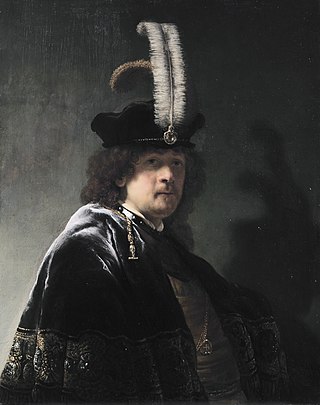
Self-portrait wearing a white feathered bonnet is an oil painting attributed to the Dutch painter Rembrandt. It is signed and dated 1635. It was traditionally regarded as a Rembrandt self-portrait until 1968, when it was rejected on stylistic grounds in the Rembrandt catalogue raisonné by Horst Gerson. In 2013, art historian Ernst van de Wetering re-attributed the painting as an original Rembrandt. It is one of over 40 painted self-portraits by Rembrandt.

A Young Archer is an oil painting, painted about 1640 by the Dutch Golden Age artist Govaert Flinck. The painting depicts a young black boy dressed as an archer. The painting is in the collection of the Wallace Collection, in London, England.

Portrait of a Man in a Yellowish-gray Jacket is an oil-on-panel portrait painting by the Dutch Golden Age painter Frans Hals, painted in 1633 and now in the Staatliche Kunstsammlungen Dresden, Dresden.

Portrait of Jan Six is a 1654 oil-on-canvas painting by the Dutch painter Rembrandt van Rijn. Having been handed down many generations, via the direct descendants of the portrait's subject, Jan Six, the work remains in the Six Collection in Amsterdam.
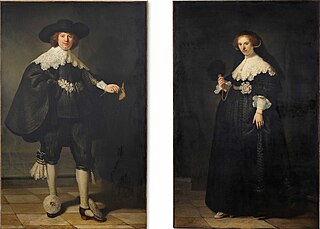
The pendant portraits of Marten Soolmans and Oopjen Coppit are a pair of full-length wedding portraits by Rembrandt. They were painted on the occasion of the marriage of Marten Soolmans and Oopjen Coppit in 1634. Formerly owned by the Rothschild family, they became jointly owned by the Louvre Museum and the Rijksmuseum in 2015 after both museums managed to contribute half of the purchase price of €160 million, a record for works by Rembrandt.

The Kitchen Maid (1651) is an oil-on-canvas painting by the Dutch painter Rembrandt. It is an example of Dutch Golden Age painting and is now in the collection of the Nationalmuseum, Stockholm, Sweden.

The Rape of Ganymede is an oil painting of 1635 by the Dutch Golden Age painter Rembrandt, depicting the myth of Ganymede. It is in the collection of the Gemäldegalerie Alte Meister in Dresden.

The Stone Bridge is a 1637 landscape painting by the Dutch Golden Age painter Rembrandt in the collection of the Rijksmuseum.
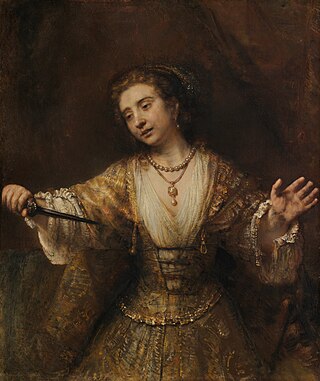
Lucretia is a 1664 history painting historically attributed to the Dutch Golden Age painter Rembrandt in the collection of the National Gallery of Art. In 2015, Ernst van de Wetering of the Rembrandt Research Project said that "the formal properties and execution of [this] painting, I am convinced, exclude the possibility that it could be an autograph work by Rembrandt", and that the painting recalls Aert de Gelder. The painting is not included in the project's 2015 Rembrandt corpus.

Portrait of a Woman, probably a Member of the Van Beresteyn Family is a 1632 oil-on-canvas portrait painting by Rembrandt. A depiction of a woman with an unusually large millstone collar, it is a pendant to Portrait of a Man, probably a Member of the Van Beresteyn Family. Both portraits are in the collection of the Metropolitan Museum of Art.

Portrait of a Man, probably a Member of the Van Beresteyn Family is an oil-on-canvas 1632 portrait painting by Rembrandt. It shows a man with a lace collar, which was a new fashion in the 1630s replacing older-styled millstone collars. It is pendant to Portrait of a Woman, probably a Member of the Van Beresteyn Family, and both are in the collection of the Metropolitan Museum of Art.

Portrait of an Old Woman is a c. 1640 portrait painting painted in the style of Jacob Adriaensz. Backer. It shows an old woman with folded hands. It is in the collection of the Metropolitan Museum of Art.

Oval Portrait of a Woman is a 1633 portrait painting painted by Rembrandt. It shows a woman with a millstone collar and diadem cap. It is in the collection of the Metropolitan Museum of Art.

Portrait of a Young Woman with a Fan is a 1633 portrait painting by Rembrandt. It shows a woman holding a fan, pendant to Portrait of a Man Rising from His Chair. It is in the collection of the Metropolitan Museum of Art.

Portrait of a Woman Wearing a Gold Chain is a 1634 portrait painted by Rembrandt. It shows a smiling woman with a triple lace collar. It is in the collection of the Museum of Fine Arts, Boston.
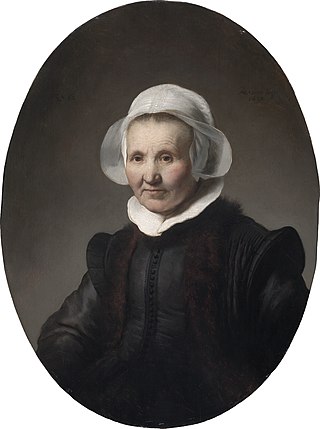
Portrait of a 62-year-old Woman, possibly Aeltje Pietersdr Uylenburgh is a 1632 portrait painting painted by Rembrandt. It is an oil on panel in oval format depicting an elderly woman with a small and sober millstone collar. It is in the collection of the Museum of Fine Arts, Boston.

Portrait of Petronella Buys (1610–1670) is a 1635 portrait painting painted by Rembrandt. It shows a young woman with a very large and impressive millstone collar. It is in a private collection.

The Standard Bearer is a three-quarter-length self-portrait by Rembrandt formerly in the Paris collection of Elie de Rothschild, and purchased by the Rijksmuseum for 175 million euros with assistance from the Dutch state and Vereniging Rembrandt in 2021. It was painted on the occasion of the artist's move from Leiden to Amsterdam and is seen as an important early work that "shows Rembrandt's ambition to paint a group portrait for the Amsterdam militia, at the time the most valued commission a painter could be awarded."
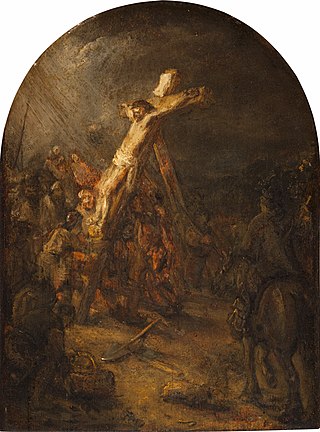
Raising of the Cross is a circa 1633-1645 painting by the Dutch Golden Age painter Rembrandt in the collection of the Museum Bredius. It was assumed to have been painted as a study for Rembrandt's larger painting of the same subject, as part of a series commissioned in 1633 by Frederick Henry, Prince of Orange. Having been rejected as autograph by the Rembrandt Research Project after Abraham Bredius's death, it was recently reattributed to the master by Jeroen Giltaij, though dendrochronology indicates the wood for the panel was not felled before 1642.




















